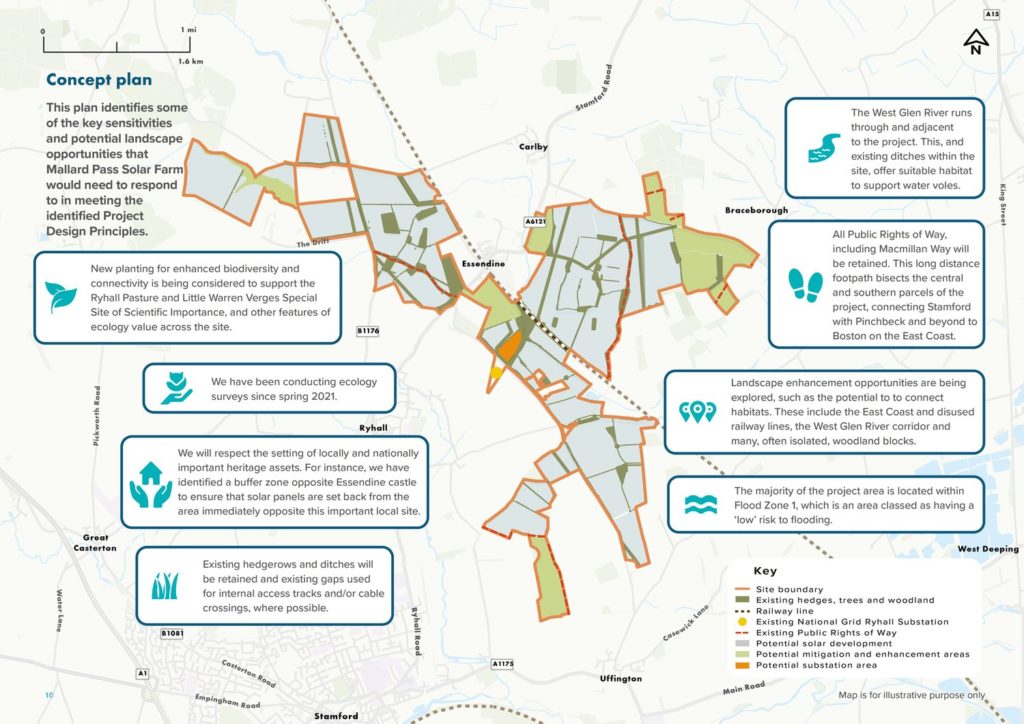Adam Brookes
Liberal Democrat Town Councillor for Market Deeping Learn more
The Mallard Pass site – Too large, too small, or just right?
by Adam Brookes on 15 December, 2021

I’m following proposals to build a solar farm on land surrounding Essendine with interest. One question that seems to keep popping up is whether the site is too big or too small to accommodate enough solar panels to deliver the 350 MW (megawatts) output the developer has mentioned.
An important point to understand here is what the site actually is and what it isn’t. In planning, we talk about the “red line”. This is to include all the land needed to carry out the proposed development.[ref] But this doesn’t mean all the land that will actually be built upon or in the ownership of the applicant.
In the case of Mallard Pass, the red line currently covers an area of 880 hectares (or 2,175 acres). This includes the existing Ryhall substation. It is the intention to use this to connect the solar farm to the national grid. So clearly it is necessary for the proposed development but there are not going to be any solar panels located there. The current red line though even includes a section of the East Coast Main Line and some roads which again won’t be replaced by solar panels.
So we have to be careful when we talk about the size of the development, particularly if we wish to make comparisons, such as to the Cleve Hill Solar Park which was approved in 2020 and which is also mentioned as having a 350 MW output.
The Mallard Pass developers have at this point provided an concept plan to show how they could achieve the 350 MW capacity within the identified site. What this doesn’t show though is the exact area covered by solar panels, only the approximate area that could accommodate solar panels.
Again, here care is required when making comparisons. A figure of 176 hectares of solar panels for Cleve Hill has been mentioned[ref], but this will literally only be the surface area of the panels themselves. The panels will most likely be arranged in rows with space between those and other features like woodland and public rights of way. There also needs to be space for access routes and equipment like inverters and substations. So to accommodate 176 hectares of solar panel surface area clearly requires much more than 176 hectares.
There are also other constraints. Some of which may be obvious, like the National Grid overhead power line, some less so, such as underground pipelines that pass through the site.
I’ve been told a rule of thumb is an acre of solar farm per 350 kW of output. For the 350 MW output, that gives a figure of around 1000 acres or just over 400 hectares.
While there are some similarities between Mallard Pass and Cleve Hill, there are also plenty of differences. MP is further north, that will inevitably require more solar panels and so likely a bigger site in order to produce the same output. MP is also clearly a more constrained site. There are more features like woodland that will require offsets.
When taking into account some of those constraints, I estimate the area of the site actually available for solar panels is around 500-600 hectares.
So I’d suggest that the site is big enough to accommodate the 350 MW output but also, subject to understanding the various constraints on the layout of solar panels, doesn’t seem excessive in size to achieve that either, at least based on the limited information currently available.
Note
I will update this post as further information becomes available and the red line is amended. I understand there may currently be some errors with the red line yet to be corrected by the developer.

Leave a Reply